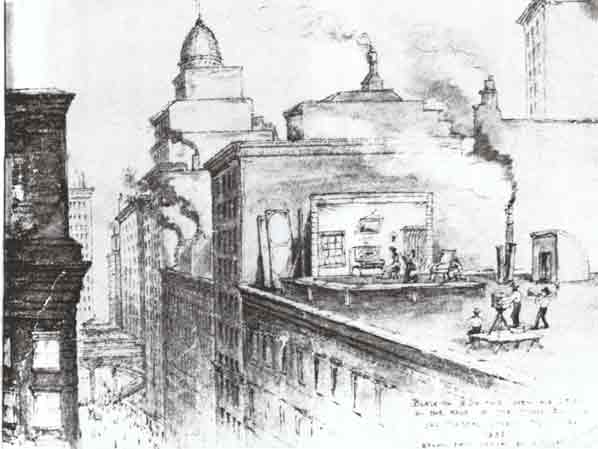
Vitagraph 2 continued from page 1
lowered upper window, giving me a panoramic view of the
onrushing scenery (still with the help of the said seat,
alas).
From this
vantage point a rather unusual landmark near the Avenue M station
catches my attention: a smokestack. A very tall smokestack, with
serifed block letters running down it: VITAGRAPH Co. I ask my
parents about it and I'm told NBC has a studio there. Vitagraph =
NBC? (Better not to ask
about the discrepancy—you know how parents hate
that.)
I picked up bits and pieces about
Vitagraph over the years but I wouldn't learn all that utilitarian
structure represents until fifty years had passed, and it is a story
that is by turns ambitious and adventurous, wacky and inspired,
crowded with colorful characters and extraordinary achievements—in
short, the kind of thing that (in the words of the Jule Styne song)
"could only happen in Brooklyn."
What happened
actually began on the other side of the Brooklyn Bridge, where a film
company was founded by two young men from the other side of the Atlantic,
J. Stuart Blackton and Albert E. Smith, whose families emigrated from
England during their childhoods. Both had a flair for show biz and, with
the addition of fellow Brit Ronald Reader, performed in a novelty act in
which Blackton was billed as the "Komikal Kartoonist," Smith the "Komikal
Konjurer." The act did not prosper and Smith took a job as a bookbinder
while Blackton found employment as a cub reporter for the New York
Evening World. In this capacity (one story goes), he was sent to interview Thomas
Edison about his invention of a moving picture projector in 1896; in
the next year the two men reunited to form a motion picture company
they called American Vitagraph.
Its
first famous product, which has a claim to being the first real motion
picture made in America, was of a train called the Black Diamond Express,
augmented by the showmanship of the partners. As a photograph of the train
suddenly came to life, Smith provided billows of smoke while Blackton in
the wings manned dishpans, hammers and tin pie plates filled with dry
beans for sound effects. If indeed a first, it was but the first of many.
In Florence Turner, the "Vitagraph Girl," they had the first major film
star; a collie named Jean, the "Vitagraph Dog" ("no-one could help making
a fine story about her, and no actor could act badly in her support"), was
the pioneer in animal stardom. The first of the great screen comedians was
the "four-dimensional" funnyman John Bunny, whose death was mourned in
Europe as fervently as in America. The Battle Cry of Peace was
produced in 1915, with the outspoken approval of such luminaries as
Theodore Roosevelt, Admiral Dewey, Elihu Root and New York Mayor John
Purroy Mitchel, to prepare America for the war in Europe, demonstrated the
propaganda impact of the young medium. In the years between the Black
Diamond Express and The Battle Cry of Peace, Vitagraph became
the most creative and forward-thinking force in the
young industry, and it couldn't have happened without the studio it
built in Brooklyn.

Vitagraph's “Open-air Studio” on the roof of Morse Building at 140 Nassau Street. (Sketch by Vitagraph co-founder J. Stuart Blackton, from Two Reels and a Crank, by Albert E. Smith.)
©2000 The Composing Stack Inc. All rights
reserved.
urbanography is a service mark of The Composing Stack
Inc.
Updated July 21,
2000.